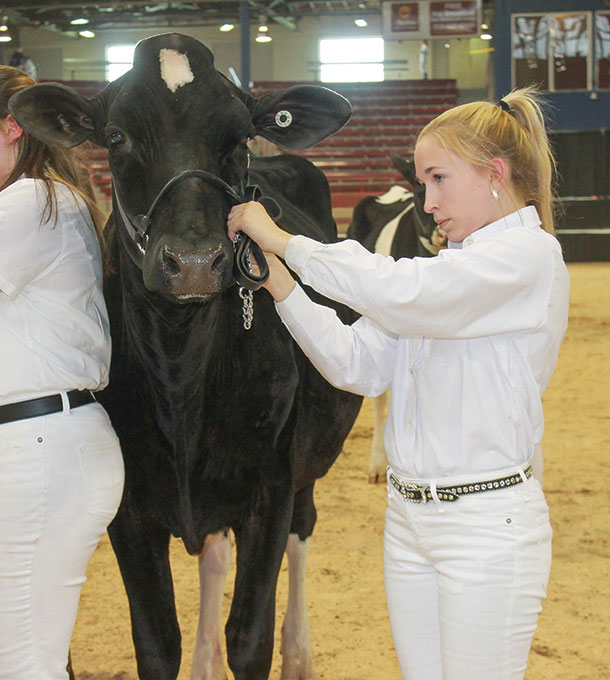We feel it’s worth repeating to remind all judges that agreeing to judge showmanship means you agree to abide by the PDCA rules and guidelines. There is no such things as “old” rules and “new” rules. There is just a present-day scorecard with legitimate reasons behind the changes, so please follow these guidelines.
Youth from across the country have invested time and money into learning these rules. As a person in youth development (which every youth show judge is), you owe it to them to learn and know how to work the ring. So let’s look at the optimal way to work a showmanship ring. By following these tips at every show you judge, you will create a consistent expectation of not only the showman; you will find that sorting any size class becomes more efficient.
1. Stand in the middle
As the exhibitors enter the ring, the judge should stand in the middle of the ring, watching each exhibitor enter. Look for these things:
- Does the halter fit properly, halfway between their nose and eyes?
- Is the exhibitor walking straight forward, 5 feet from the wall and 5 feet from the person ahead of them?
- Is the exhibitor watching both you and their heifer equally?
- Is the exhibitor moving at an efficient pace? Too many times this year I have seen youth enter at a very slow pace. As the judge, it is your responsibility to ask them to move into the ring.
- Once the last exhibitor is in the ring, observe who turns around and begins walking backward out in front of their heifer at a slightly slower pace.
2. Next, begin close inspection
Choose an animal to begin this process. I suggest doing close inspection away from the doorway, as many animals don’t behave as well at this point of the ring.
- Stop all of the animals by holding up both hands or by a verbal command to stop and set up.
- Go to the first animal, walk around the front of it to observe if the showperson turns to look at you and presents a good view of the front end. Stop and look at the front end of the animal. Check for cleanliness of head and ears at this point.
- As you move to the outside of the animal, the exhibitor should be moving their heifer’s leg to the proper position, with the leg closest to the judge, back.
- Watch to see that they are at least attempting this. Those who have their animal trained to perfection should be able to set up quickly and correctly. Look for whether the exhibitor knows to do this and is attempting to set the animal up correctly. This is one time that not perfect is acceptable.
- Move back into the center of the ring and look around the ring to discreetly check to see what each exhibitor is doing. If you see that a number of animals or exhibitors are out of place, ask all of the exhibitors to move 5 to 10 feet to get spacing back.
- After close inspection on three to five animals, depending on the size of the class, ask all of the exhibitors to move 5 to 10 feet. This gives those who had a problem setting their animal up the first time another chance to step up correctly.
- Repeat this process until every animal has been looked at up close.
What to look for during close inspection:
- The exhibitor stands up straight and out in front of their animal.
- The exhibitor turns and presents their animal with their left hand in the halter when the judge walks to the front of the heifer so that the judge can view the front end.
- The exhibitor knows to move the heifer’s feet as soon as the judge moves toward the outside.
- The exhibitor knows to set up the rear legs first and then the front legs.
- All class participants are keeping the ring in good order as far as spacing and presentation of animal.
 3. Bringing the animals to the line
3. Bringing the animals to the line
Now that you have completed the second step of evaluating the class, it’s time to line up the class. Entering the line and in-line performance of an exhibitor and their heifer is worth about one-third of the scorecard, so the judge must have at least two line-ups in order to properly evaluate the exhibitors. Never make only one pull to the line in a showmanship class.
- Pull exhibitors in by placing them in a tentative order, or you may pull them in randomly.
As they are entering the line, evaluate these areas:
- Is the exhibitor watching when you signal them to go to the line?
- The exhibitor should walk forward and move at an efficient pace, similar to the pace at which they entered the ring. They should not run.
- The exhibitor should keep their left hand in the halter and hold the animal’s head up.
- Once they get to the back of the line, the exhibitor should slow down, turn to their heifer and enter the line so that they can get their heifer set up with her legs under her.
- The exhibitor should set the back legs up first and be sure that she is not too stretched out or too coupled.
- The shoulders or front feet of the heifers in line should be lined up.
- There should be only the width of the showman between animals. Those who crowd or leave too much space should receive some degree of discrimination.
4.  In the line
In the line
Once you have everyone into line, you should walk from one end of the line to the other and then around to the front of the line. Here is what you are looking for at this point in the class:
- The first heifer in line is placed with her outside rear leg back. The last heifer in line has her outside leg back as well. Why? Because a heifer looks longer when this leg is back, so when a judge can get a full side view of a heifer, the leg should be back. These people do not move the legs as the judge walks from side to side.
- All of the other heifers in line get set up and do not need to move their rear legs. If a heifer looks good, the exhibitor should leave her alone. This has nothing to do with being well trained or how many hours a heifer has been worked with. The judge cannot see the side view of the heifer, so there is no reason to move her. Don’t ever penalize exhibitors for not moving feet in line if a heifer is set up well.
- When you walk to the front, the exhibitor should turn and look at you without disturbing the heifer next to them. Their left hand should be in the halter and they should be standing up straight. Extra points for an added look of confidence.
Special tip: You may want to pull a few exhibitors forward into a short line and see how the person on each end of the smaller line sets up; that is a great way to separate a close class. You never need to put a cow on the end, as a cow needs her legs switched each time the judge moves to a new side. This is for intermediate or advanced classes only.
5. The final line-up
Now it’s time to make the final pull. Start selecting your final line-up with your top showperson. When selected, watch for a showperson to move out efficiently while you are selecting others to follow. This is the time in the class that exhibitors should be giving you their very best look.

Once they are back in full view of you, they should turn and walk backwards until you give the signal for them to make their final line. Don’t be afraid to juggle a few placings if you feel a showperson has either quit showing or if they have corrected earlier problems.
A few final tips:
- Talking among exhibitors in a class is not permitted, so it’s good to give a warning.
- If an exhibitor has a big problem such as a halter that is too big, walk over and help them make it smaller right at the beginning of the class.
- If heifers are obviously broke to lead well and yet are having a bad day, put the exhibitor’s mind at ease by telling them you will evaluate how they handle the situation. We’ve all shown very well-broke heifers that have bad days.
- You control the ring.
- Every time you look up from a heifer, the ring should look well-spaced with animals presented in a side profile.
- Never ask a class to stop and stand for more than two to three minutes. This is unfair to heifers and exhibitors alike.
We hope to see youth dairy show judges at the upcoming Showmanship Judges Conference on Monday, Sept. 30, at 2 p.m. at World Dairy Expo, or at a showmanship clinic near you for more tips and coaching. ![]()
PHOTO 1: When performing a close inspection during a showmanship class, judges should look for a properly fitting show halter, with the exhibitor’s left hand inside the halter.
PHOTO 2: This exhibitor displays the “look of confidence.” Photos by Katie Coyne.

-
Katie Coyne
- Owner
- Mill Wheel Dairy Show Clinics
- Email Katie Coyne






